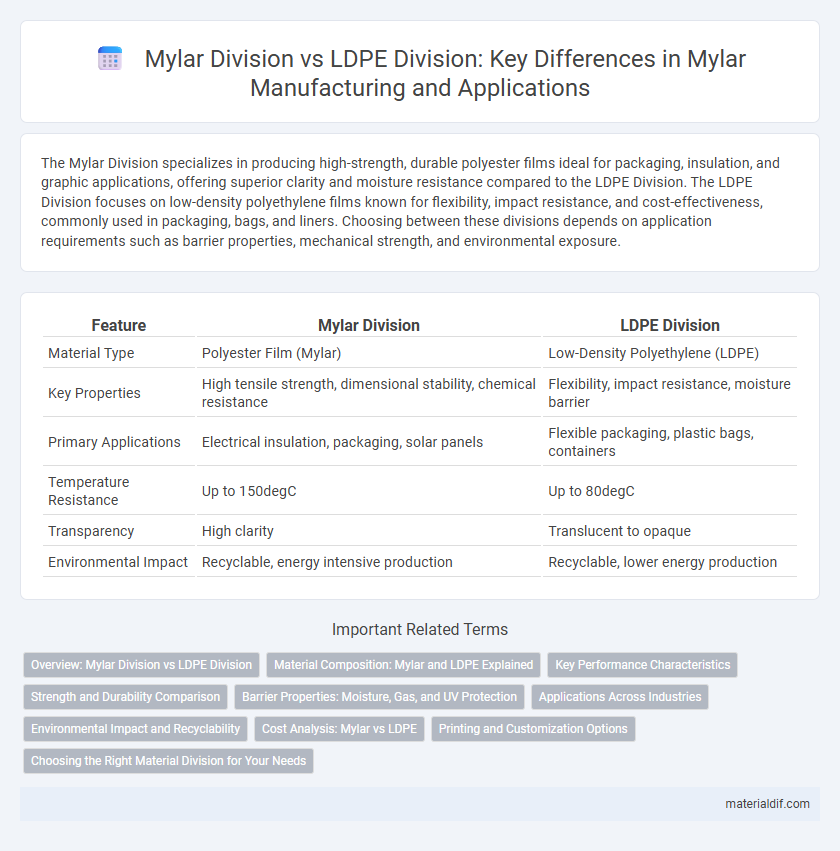The Mylar Division specializes in producing high-strength, durable polyester films ideal for packaging, insulation, and graphic applications, offering superior clarity and moisture resistance compared to the LDPE Division. The LDPE Division focuses on low-density polyethylene films known for flexibility, impact resistance, and cost-effectiveness, commonly used in packaging, bags, and liners. Choosing between these divisions depends on application requirements such as barrier properties, mechanical strength, and environmental exposure.
Table of Comparison
| Feature | Mylar Division | LDPE Division |
|---|---|---|
| Material Type | Polyester Film (Mylar) | Low-Density Polyethylene (LDPE) |
| Key Properties | High tensile strength, dimensional stability, chemical resistance | Flexibility, impact resistance, moisture barrier |
| Primary Applications | Electrical insulation, packaging, solar panels | Flexible packaging, plastic bags, containers |
| Temperature Resistance | Up to 150degC | Up to 80degC |
| Transparency | High clarity | Translucent to opaque |
| Environmental Impact | Recyclable, energy intensive production | Recyclable, lower energy production |
Overview: Mylar Division vs LDPE Division
The Mylar Division specializes in manufacturing biaxially-oriented polyethylene terephthalate (BoPET) films known for high tensile strength, clarity, and thermal stability, widely used in packaging, insulation, and electronics. The LDPE Division produces low-density polyethylene films valued for flexibility, moisture resistance, and cost-effectiveness, primarily used in flexible packaging, agricultural films, and liners. Mylar films offer superior barrier properties and dimensional stability, whereas LDPE films provide enhanced softness and sealability, catering to distinct industrial applications.
Material Composition: Mylar and LDPE Explained
Mylar is a polyester film primarily composed of polyethylene terephthalate (PET), known for its high tensile strength, chemical stability, and excellent barrier properties. The LDPE division uses low-density polyethylene, a thermoplastic made from the polymerization of ethylene, characterized by its flexibility, moisture resistance, and lower melting point. Mylar's crystalline structure provides superior durability and clarity compared to the more elastic and softer nature of LDPE film.
Key Performance Characteristics
Mylar Division offers exceptional tensile strength, dimensional stability, and high-temperature resistance, making it ideal for electrical insulation and packaging applications. The LDPE Division excels in flexibility, impact resistance, and moisture barrier properties, suited for lightweight packaging and film wrapping. Mylar's superior clarity and chemical inertness differentiate it from LDPE's cost-effectiveness and superior sealing capabilities.
Strength and Durability Comparison
Mylar Division consistently delivers superior strength and durability compared to the LDPE Division, thanks to its polyester film composition, which provides exceptional tensile strength and resistance to stretching. Mylar films exhibit outstanding dimensional stability and resistance to tears, making them ideal for applications demanding long-term durability under stress. In contrast, LDPE films, while flexible and cost-effective, tend to have lower mechanical strength and are more susceptible to punctures and wear over time.
Barrier Properties: Moisture, Gas, and UV Protection
Mylar division offers superior moisture and gas barrier properties compared to the LDPE division, ensuring enhanced product preservation and shelf life. Mylar's polyethylene terephthalate (PET) composition provides excellent UV protection, preventing degradation from sunlight exposure. In contrast, LDPE films typically exhibit lower resistance to moisture and gases, making Mylar the preferred choice for high-performance barrier applications.
Applications Across Industries
Mylar Division excels in advanced applications requiring high tensile strength, dimensional stability, and chemical resistance, making it ideal for the electronics, packaging, and automotive industries. LDPE Division, known for its flexibility, impact resistance, and moisture barrier properties, serves diverse sectors such as food packaging, agriculture, and medical supplies. The contrasting material properties determine their specialization: Mylar's durability suits high-performance uses, while LDPE's adaptability supports cost-effective and versatile solutions.
Environmental Impact and Recyclability
Mylar Division products, primarily made from biaxially-oriented polyethylene terephthalate (BoPET), offer superior recyclability compared to LDPE Division products, which are based on low-density polyethylene. The environmental impact of Mylar films is lower due to their enhanced durability, reduced material usage, and higher potential for reuse and recycling in industrial applications. In contrast, LDPE films contribute more significantly to plastic waste challenges because of their slower degradation and limited recycling infrastructure.
Cost Analysis: Mylar vs LDPE
The Mylar division incurs higher production costs compared to the LDPE division due to the expensive raw materials and complex manufacturing processes involved. LDPE offers a more cost-effective alternative with lower material expenses and simpler extrusion techniques, resulting in reduced overall operational costs. Despite the initial expense, Mylar's superior durability and barrier properties can justify its higher price in applications demanding enhanced performance.
Printing and Customization Options
Mylar Division specializes in high-quality printing and offers advanced customization options such as metallic finishes, UV coatings, and high-resolution graphics, ideal for premium packaging and promotional materials. LDPE Division focuses on flexible printing solutions with limited color ranges and standard matte or gloss finishes, prioritizing cost-effective, bulk production with basic customization. Businesses seeking vibrant, durable, and visually appealing prints typically prefer Mylar's offerings, while those valuing affordability and flexibility lean towards LDPE products.
Choosing the Right Material Division for Your Needs
Mylar Division specializes in polyester films known for high tensile strength, excellent chemical resistance, and superior dimensional stability, making it ideal for industrial applications and electrical insulation. The LDPE Division offers low-density polyethylene films characterized by flexibility, moisture resistance, and cost-effectiveness, suited for packaging and protective coverings. Selecting the appropriate division depends on the required material properties such as durability, transparency, and environmental resistance tailored to specific operational demands.
Mylar Division vs LDPE Division Infographic

 materialdif.com
materialdif.com